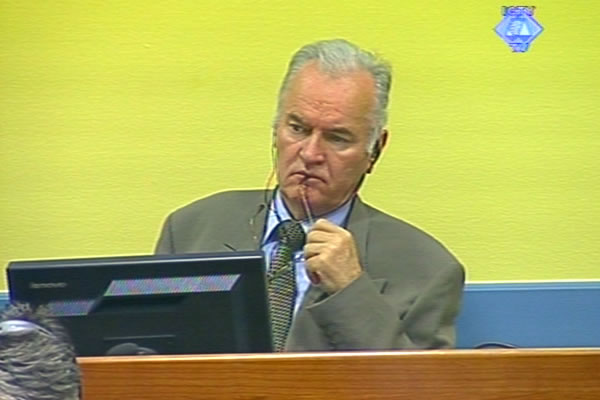Home
WHICH HALF OF THE HOSPITAL WAS SHELLED MORE?
In the cross-examination of Dr Bakir Nakas, Ratko Mladic’s defense counsel suggested that the Sarajevo Military Hospital had already been shelled while the JNA had still occupied it. According to the defense, the damage to the right-hand half of the southern façade could have been caused by the shells fired from the BH Army positions at Debelo Brdo
 Ratko Mladic in the courtroom
Ratko Mladic in the courtroom Most of the cross-examination of Dr Bakir Nakas, director of the Sarajevo State Hospital, which has been renamed Dr Abdulah Nakas Hospital, focused on the effort to establish which half of the southern façade of the building was shelled more. Dr Nakas said that the former military hospital in Sarajevo had been constantly targeted by the Sarajevo-Romanija Corps artillery, firing from the direction of Mount Trebevic, Vrace and Grbavica.
Using a map and a photo, the defense counsel put it to the witness that Debelo Brdo was on the same line as Mount Trebevic. ‘During the entire war Debelo Brdo was under the control of the BH Army’, the defense counsel insisted, and ‘the southern wing of the hospital was clearly visible’ from that elevation. Dr Nakas confirmed that there was no ‘physical barrier’ between the hospital and Debelo Brdo.
The witness’s ‘rough assessment’ was that the southern façade of the hospital was targeted by heavier artillery – mortars and tanks. Dr Nakas added that the artillery fired mostly on areas where patients were, mostly on the 5th, 7th and 8th floors. According to Dr Nakas, the central and the right-hand side of the southern façade were most often shelled.
The defense counsel put it to the witness that until 10 May 1992, when the JNA withdrew, the Military Hospital ‘was threatened by the Muslim armed forces; they also fired on it from snipers’. Quoting the then director of the Military Hospital, Dr Tausan, the defense counsel claimed there had been media reports that the JNA was using the hospital to ‘snipe at passers-by’. On the other hand, Dr Nakas confirmed that there ‘were comments’ to the effect that the Territorial Defense soldiers who had ‘taken up arms to defend BH’ fired on the Military Hospital from snipers. However, Dr Nakas insisted he ‘never saw that’. Dr Nakas also confirmed that after the Military Hospital was taken over from the JNA and renamed the State Hospital, damage that had probably been caused by a mortar shell was observed on the southern façade between the 7th and 8th floors. There were also holes, most likely caused by bullets fired at point-blank range, the witness noted.
As the defense counsel claimed, Dr Tausan said that the fiercest attack on the hospital occurred in late April, and that the fire came from the direction of the Magribija Mosque, where the Muslim forces purportedly had their weapons depot. The witness repeated that he was away in that period. Dr Tausan couldn’t see the mosque from the hospital and he couldn’t leave the hospital perimeter because a special unit detachment controlled the movements of the staff. Dr Nakas said that in his view there was no reason for the presence of the detachment in the hospital. The only reason why the detachment was deployed there was to split the city in two parts. Finally, the defense counsel put it to the witness that there was a HOS unit in the close proximity of the hospital and that the ‘HVO and the BH Territorial Defense clashed’ near the hospital in December 1992.
After Dr Nakas completed his evidence, the prosecution called Edin Suljic. He used to work for the Sarajevo Security Services Center and took part in the on-site investigation at the Markale town market on 5 February 1994. A mortar shell killed 67 and wounded 142 people there. The names of the victims are attached to the criminal report Suljic wrote after the incident. Edin Suljic will continue his testimony tomorrow.
